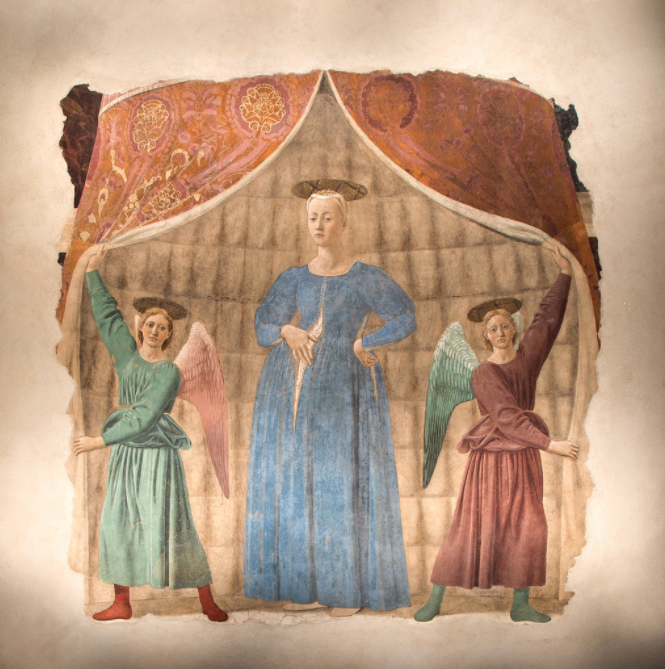Beth McDermott, Series Contributor
Beth’s series “Ekphrastic Possibility” explores what ekphrasis is, its evolution with the lyric tradition, and the craft of writing ekphrastic poems.
One might consider Homer’s description of Achilles’ shield or Ashbery’s “Self-Portrait in a Convex Mirror” to be touchstone ekphrastic poems because of where they exist in the ekphrastic tradition, creating bookends for a kind of continuum James A. W. Heffernan charts in Museum of Words: The Poetics of Ekphrasis from Homer to Ashbery. For Heffernan, both of these writers’ texts illustrate the impetus to narrate the ostensibly fixed image, with Ashbery’s meditative poem not only narrating, but also commenting on the nature of representation, by turns addressing the painter and the art critic, ushering ekphrasis into the postmodern age. But just less than a decade after Ashbery published “Self-Portrait” in the August, 1974 issue of Poetry, Jorie Graham wrote “San Sepolcro”: a poem Heffernan might have looked at in his 1993 study that is heavy on male poets and also maintains, as part of its theoretical argument, a male/female antagonism between poetry and visual art. While Heffernan is not the first to put “the sister arts” in a contested relationship, his argument that the relationship is binary and gendered perpetuates a limited understanding of sex and gender and ignores the way poets like Graham and Elizabeth Bishop have used ekphrasis to overlap perspectives, rather than create division. Despite these limitations, Heffernan’s definition of ekphrasis as “a verbal representation of a visual representation” (3) is useful for keeping in mind that ekphrasis is characterized by layers of representation, and is often quoted in literature that acknowledges the difficulty of clearly defining an ancient and ever-changing mode.
But maybe there’s more relevance to ekphrasis’ ancient roots than a gendered contest for mastery would allow. The “Theories of Media” glossary at The University of Chicago describes how ekphrasis was taught as an exercise to Greek students of rhetoric: “The student of ekphrasis was encouraged to lend their attention not only to the qualities immediately available in an object, but to make efforts to embody qualities beyond the physical aspects of the work they were observing.” Here I’m especially interested in what it means to “embody qualities beyond the physical aspects of the work,” and whether thinking about a space beyond the work might allow us to see the ekphrastic poem and the visual representation it re-presents as contingent: a partnership that evidences either text’s insufficiency, rather than the potential for one to silence the other. What if the best ekphrasis, informed by its ancient history, gestures beyond the physical work in an effort to broaden or deepen the frame lines that bestow upon the work its perceived autonomy?
Graham’s “San Sepolcro” is a clear example of ekphrasis moving beyond the physical work and allowing the reader to participate in what I will call “deep seeing.” Rather than the poem being another static object alongside or in contest with the two-dimensional painting, Graham’s ekphrasis argues for contingency between poem, painting, and history. The narrative impulse Heffernan claims of ekphrasis is observable in the way Graham expands the spatial and temporal dimensions of the Madonna del Parto, a fresco by Piero della Francesca. But Graham’s narrative impulse is more concise than digressive, and might be better described as a lyric impulse, especially if we keep in mind Helen Vendler’s response to sociopsychological critics in The Art of Shakespeare’s Sonnets. Arguing against “the persistent wish to turn the sequence [of the Sonnets] into a novel (or a drama),” Vendler cautions against forgetting that “the true ‘actors’ in lyric are words, not ‘dramatic persons’” (2-3). The lyric impulse in Graham’s ekphrasis doesn’t narrate the fresco so much as pierces it, drawing the arrow back to a point in history that doesn’t quite exist. If one were to sketch the shape of the deep seeing “San Sepolcro” enacts, it would look like an acute-angle opening onto contingency. The depth that Graham’s lyric impulse achieves through linguistic play that embodies both the structure of the poem and the structure of thinking (Vendler 3) undercuts the iconic, two-dimensional representation of Christ’s impending birth; instead of keeping us at a respectful distance, Graham’s speaker welcomes us to “go in.”
The first poem of Jorie Graham’s second collection, Erosion (1983), “San Sepolcro” begins with an invitation:
In this blue light
I can take you there,
snow having made me
a world of bone
seen through to. This
is my house,
my section of Etruscan
wall, my neighbor’s
lemontrees, and, just below
the lower church,
the airplane factory.
The invitation to go with the speaker is possible due to coldness on loan from snow—a great leveler. The lines “snow having made me / a world of bone” work in two ways: syntactically, the speaker and her world are “bone / seen through to,” which also makes sense on a biological level: the speaker doesn’t exist apart from her surroundings; she exists in a world of bone. Even her “Etruscan” wall (by far one of the most curious words in the poem), suggests that she is not outside of time but of time, part of a pre-Christian culture suppressed by a growing Roman empire. She is a relic, like her section of wall is, and the word “bone” implies.
This contingency between the speaker and her surroundings is further emphasized in the description that ensues:
A rooster
crows all day from mist
outside the walls.
There’s milk on the air,
ice on the oily
lemonskins. How clean
the mind is,
holy grave. It is this girl
by Piero
della Francesca, unbuttoning
her blue dress,
her mantle of weather,
to go into
labor.
In a place like San Sepolcro, with its porousness belying the conqueror’s attempt to erase history, Graham’s omniscient speaker perceives the barely perceptible elements that coat and penetrate the living. She herself partakes in this overlapping: the mind metaphorically transitions to the girl in the painting in a clean lateral sweep reminiscent of a brush sweeping the canvas. The mind is “this girl / by Piero / della Francesca,” as if the speaker doesn’t exist separate from what she perceives. In numerous ekphrastic poems the description is so heavy that we may hunger for a narrator’s presence. But whether there are “dramatic persons” or not, perspectives exist; we come to know them through what Vendler calls “the structure of thinking” mimicked by the poem’s structure and the words themselves (3). In the case of “San Sepolcro,” description of the painting doesn’t occupy that much of the poem. But much like her predecessor William Carlos Williams, Graham’s speaker doesn’t stand back and reflect on her emotional connection to the painting; chilled to the bone, the speaker’s mind presses against the painting, which, like snow, gives way. We are thus permitted to enter into history:
Come, we can go in.
It is before
the birth of god. No one
has risen yet
to the museums, to the assembly
line--bodies
and wings--to the open air
market. This is
what the living do: go in.
It’s a long way.
And the dress keeps opening
from eternity
to privacy, quickening.
Questions of ownership exist in the white space between “eternity” and “privacy”: before god, one is permitted entry; art exists outside of the museum, and money hasn’t yet exchanged hands. But “privacy” is where things resist, however quickly that resistance is overcome:
Inside, at the heart,
is tragedy, the present moment
forever stillborn,
but going in, each breath
is a button
coming undone, something terribly
nimble-fingered
finding all of the stops.
Of course this is an erotic poem, and the painting is, too; the Madonna has her hand at the seam where her dress has begun to open—exactly where Graham’s speaker finds entryway into the painting. But the poem is about the act of “going in,” not the big reveal. Although the last few lines are “meta” in the sense that “stops” is self-referential, “going in” is an endless process that’s bigger than our private lives. It’s the search for truth, not truth itself. The poem teaches, through ekphrasis, deep seeing in the drama of its unfolding, in the speaker, alive as any of us, doing what the living do.
Works Cited:
Graham, Jorie. Erosion. Princeton UP, 1983.
Heffernan, James A. W. Museum of Words: The Poetics of Ekphrasis from Homer to Ashbery. U of Chicago, 1993.
Vendler, Helen. The Art of Shakespeare’s Sonnets. The Belknap Press of Harvard UP, 1997.
≅
Beth McDermott is the author of a chapbook titled How to Leave a Farmhouse (Porkbelly 2015), an associate editor with RHINO, and poetry editor for Kudzu House Quarterly. Her poetry has appeared in journals such as DIAGRAM, Storm Cellar, and Southern Humanities Review, and she regularly reviews for American Book Review. She’s an assistant professor of English at the University of St. Francis and lives in New Lenox, IL.


